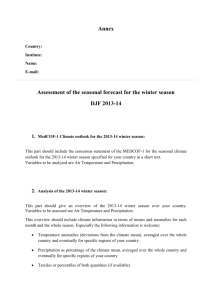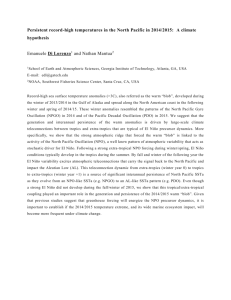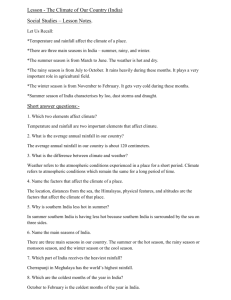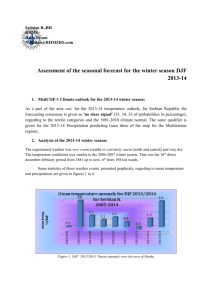here.
advertisement
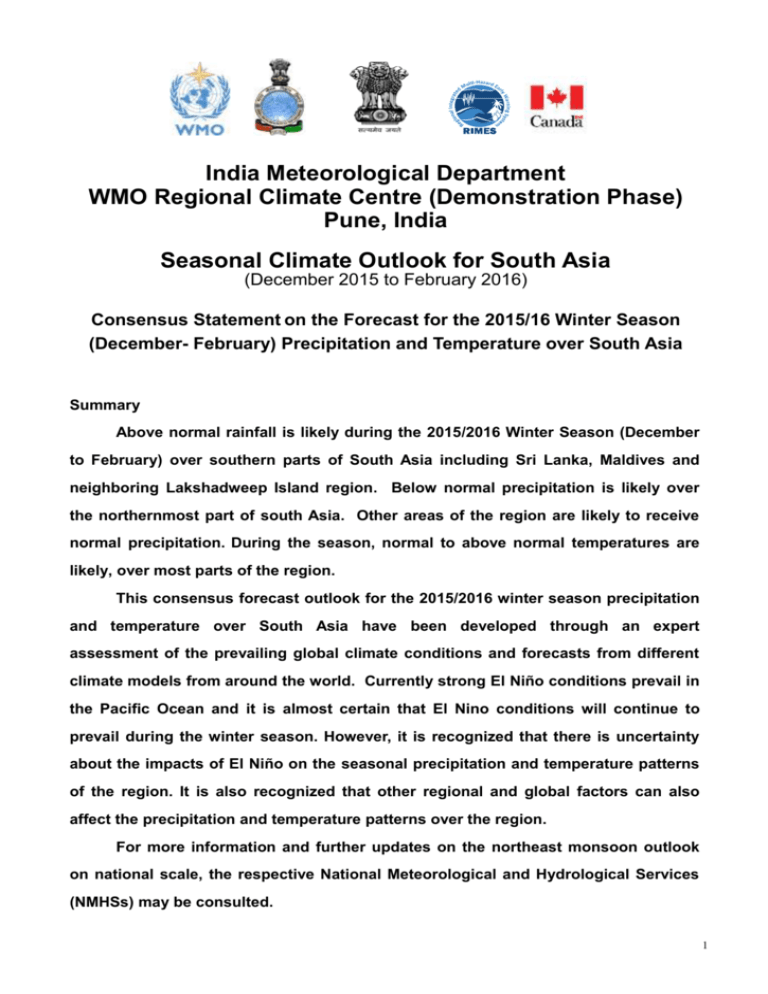
India Meteorological Department WMO Regional Climate Centre (Demonstration Phase) Pune, India Seasonal Climate Outlook for South Asia (December 2015 to February 2016) Consensus Statement on the Forecast for the 2015/16 Winter Season (December- February) Precipitation and Temperature over South Asia Summary Above normal rainfall is likely during the 2015/2016 Winter Season (December to February) over southern parts of South Asia including Sri Lanka, Maldives and neighboring Lakshadweep Island region. Below normal precipitation is likely over the northernmost part of south Asia. Other areas of the region are likely to receive normal precipitation. During the season, normal to above normal temperatures are likely, over most parts of the region. This consensus forecast outlook for the 2015/2016 winter season precipitation and temperature over South Asia have been developed through an expert assessment of the prevailing global climate conditions and forecasts from different climate models from around the world. Currently strong El Niño conditions prevail in the Pacific Ocean and it is almost certain that El Nino conditions will continue to prevail during the winter season. However, it is recognized that there is uncertainty about the impacts of El Niño on the seasonal precipitation and temperature patterns of the region. It is also recognized that other regional and global factors can also affect the precipitation and temperature patterns over the region. For more information and further updates on the northeast monsoon outlook on national scale, the respective National Meteorological and Hydrological Services (NMHSs) may be consulted. 1 Introduction: During the winter season (December to January), Northern parts of South Asia receive good amounts of precipitation in the form of both snow and rain falls. Southern part of the region consisting of southeastern part of India, Sri Lanka and Maldives also receive good amounts of rainfalls during the season. It is recognized that the seasonal predictability of the region during the season is limited to some extent due to the strong day to day atmospheric variability. The day to day atmospheric variability over the northern (southern) part the region is caused by the passage of disturbances in the mid latitude westerlies (tropical easterlies). The seasonal predictability over southern part of the region is also limited by the eastward moving Madden Julian Oscillation (MJO), which represents the major global scale intraseasonal variability pattern. The consensus climate outlook for the 2015/2016 winter season (December to February) was prepared through exchange of expert assessment among a team of experts from all the countries of South Asia. The expert team discussed various observed and emerging climatic features that are known to influence the climate of the region such as the El Niño-Southern Oscillation (ENSO) conditions over the equatorial Pacific, Indian Ocean Dipole (IOD) conditions over the Indian Ocean etc. The key features of these conditions are as follows. ENSO Conditions over the Pacific Ocean Since late July, strong El Nino conditions are prevailing over the equatorial Pacific. The atmospheric conditions over the Pacific also reflect patterns consistent with the El Niño conditions. Latest forecasts indicate that the El Niño conditions are nearly certain to persist till early part of the next year with the possibility of slight further strengthening just prior to the end of this year. The El Nino is likely to start weakening thereafter and reach to normal level by end of spring season of next year. Models and expert opinion also suggest that sea surface temperatures in the east-central tropical Pacific Ocean are likely to exceed 2° Celsius above average, potentially placing this El Niño event among the four strongest events since 1950 (1972-73, 1982-83, 1997-98). 2 Conditions over the Indian Ocean In addition to ENSO conditions over the Pacific, other factors such as Indian Ocean sea surface temperatures (SSTs) have some influence on the climate of the region. At present, positive SST anomalies are observed over most parts of the tropical Indian Ocean with slight positive Indian Ocean Dipole (IOD) over equatorial Indian Ocean. Recent forecasts from coupled models suggest positive IOD conditions to weaken and turn to neutral IOD conditions during early part of next year. Consensus Outlook for the 2015/2016 Winter Season Precipitation and Temperature over South Asia: A consensus outlook for the winter season rainfall over South Asia has been prepared based on the expert assessment of prevailing large-scale global climate indicators mentioned above and experimental as well as operational long-range forecasts based on the statistical and dynamical models generated by various operational and research centres of the world. There is unanimity among the experts that the prevailing strong El Niño conditions in the equatorial Pacific is near-certain to continue till early part of the next year. However, it is recognized that there is some uncertainty on the potential impacts of El Niño on the climate of the region due to strong day to day atmospheric variability generally observed in the region. Based on the historical data, it has been observed that during El Niño years, in general, southern parts of the region including southern Peninsular India, Sri Lanka and Maldives receive above normal winter monsoon rainfall. However, it is important to note that El Niño is not the only factor that decides the performance of winter monsoon over the region. Other relevant climate drivers such as the state of the Indian Ocean Dipole, the Tropical Atlantic SST etc. are also important. The relative impact of all these parameters needs to be considered to determine the rainfall over the region. However, the impact of El Nino on the winter season precipitation over northern Part of the South Asia is not very clear particularly due to strong day to day atmospheric variability over the region. 3 The outlook for winter season precipitation over South Asia is shown in Fig.1. The figure illustrates the most likely categories over the region, as well as the probabilities for each tercile category1. The tercile probabilities were derived by synthesis of the available information and expert assessment. The outlook suggests that during the 2015/2016 Winter Season (December to February), above normal rainfall is likely over southern parts of South Asia including Sri Lanka, Maldives and neighboring Lakshadweep region. Below normal precipitation is likely over the northernmost part of south Asia. Other areas of the region are likely to receive normal precipitation. During the season, normal to above normal temperatures are likely, over most parts of the region Fig.1 Consensus outlook for 2015/2016 winter season precipitation over South Asia. Tercile categories have equal climatological probabilities, of 33.33% each. 1 4

